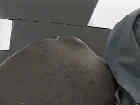Skip to content
 Discussion
Discussion
- AC joint is situated between the clavicle and acromion;
- acromion has two ossification centers which fuse at age 22 yrs;
- it permits motion in three planes:
- AP gliding of acromion during protraction & retraction of scapula;
- tilting of acromion during abduction & adduction of arm;
- rotation of the clavicle;
- rotation occurs during abduction & adduction of shoulder.
Anatomy
- innervation: provided by the suprascapular and lateral pectoral nerves
- ref: The suprascapular nerve and its articular branch to the acromioclavicular joint: an anatomic study
- joint is reinforced by two sets of ligaments:
- AC ligament
- directed horizontally, and functionally the AC joints control horizontal stability;
- palpable shallow depression between end of clavicle & acromion;
- superior AC lig is most important ligament in stabilizing AC joint for normal daily activities;
- coracoclavicular ligaments:
- stronger, vertically directed contains conoid and trapezoid ligaments help to control vertical stability;
- coracoclavicular lig are suspensory ligaments of upper limb;
- conoid:
- is the most important ligament for support of the joint against significant injuries and superior displacement;
- cone shaped which extends between the conoid tubercle on the posterior clavicle and the base of the coracoid;
- trapezoid:
- resists AC joint compression;
- begins anteriorly and laterally to the conoid ligament on the clavicle and inserts on the coracoid process;
- reference: Biomechanical study of the ligamentous system of the acromioclavicular joint.
- - Sternoclavicular joint:
Management of Specific Injuries
Exam
Radiology
References
 Discussion
Discussion


